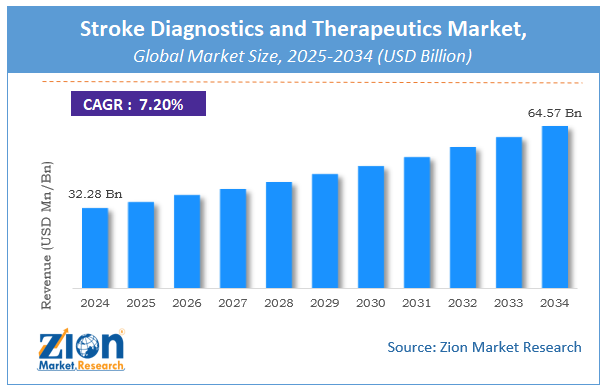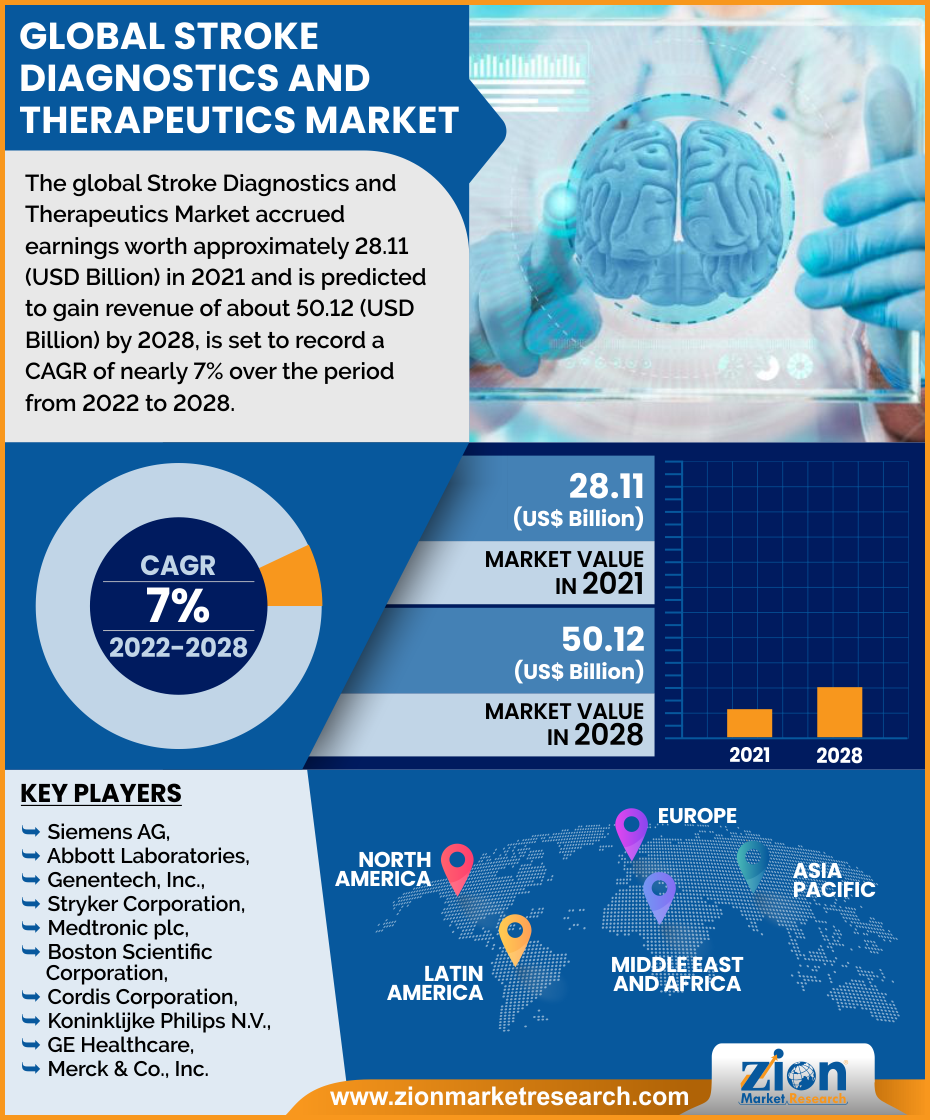Stroke Diagnostics and Therapeutics Market Size, Global Industry Report 2034

Stroke Diagnostics and Therapeutics Market - By Diagnostics (Magnetic Resonance Imaging, Computed Tomography Scan, Electrocardiography, Carotid Ultrasound, Cerebral Angiography, and Others), By Therapeutics (Tissue Plasminogen Activator, Antiplatelet, Antihypertensive, and Anticoagulant), By Application (Ischemic Stroke and Hemorrhagic Stroke), and By Region: Global Industry Perspective, Comprehensive Analysis, And Forecast, 2025 - 2034
| Market Size in 2024 | Market Forecast in 2034 | CAGR (in %) | Base Year |
|---|---|---|---|
| USD 32.28 Billion | USD 64.57 Billion | 7.2% | 2024 |
Stroke Diagnostics and Therapeutics Market: Industry Perspective
The global stroke diagnostics and therapeutics market size was worth around USD 32.28 Billion in 2024 and is predicted to grow to around USD 64.57 Billion by 2034 with a compound annual growth rate 7.2% between 2025 and 2034
The report analyzes the global stroke diagnostics and therapeutics market's drivers, restraints/challenges, and the effect they have on the demands during the projection period. In addition, the report explores emerging opportunities in the stroke diagnostics and therapeutics industry.
Stroke Diagnostics and Therapeutics Market: Overview
A stroke is the medical emergency condition, seen mostly in elderly age patients. Strokes happen when blood flow to brain stops and brain cells begin to die. There are two kinds of stroke which include ischemic stroke and hemorrhagic stroke. Ischemic stroke is the most common type of stroke and is caused by a blood clot that blocks a blood vessel in the brain. The other stroke is called hemorrhagic stroke and is caused by a blood vessel that breaks and bleeds into the brain.
Attack on brain is referred as stroke and it is caused due to reduction of blood supply to brain. This has resulted in brain not getting appropriate proportion of oxygen causing brain cells to die. Increase in people prone to stokes will steer expansion of stroke diagnostics and therapeutics industry. There are three kinds of stroke including ischemic, transient ischemic attacks, and hemorrhagic. In first kind, i.e. ischemic stroke, flow of blood to brain is reduced in arteries owing to narrowed & blocked blood vessels. Hemorrhagic stroke is due to brain arteries leaking or bursting.
However, transient ischemic attacks interrupt temporary blood flow to brain for shorter period. Diagnosis of stroke includes MRI scanning, ultrasound, CT scan, echocardiogram, and cerebral angiogram. The treatment or therapeutics part include intake of aspirin, anticoagulants, and antiplatelets.
Key Insights
- As per the analysis shared by our research analyst, the global stroke diagnostics and therapeutics market is estimated to grow annually at a CAGR of around 7.2% over the forecast period (2025-2034).
- Regarding revenue, the global stroke diagnostics and therapeutics market size was valued at around USD 32.28 Billion in 2024 and is projected to reach USD 64.57 Billion by 2034.
- The stroke diagnostics and therapeutics market is projected to grow at a significant rate due to rising stroke prevalence, advancements in imaging and treatment technologies, increasing geriatric population, growing awareness of early diagnosis, and government initiatives for stroke care improvement.
- Based on Diagnostics, the Magnetic Resonance Imaging segment is expected to lead the global market.
- On the basis of Therapeutics, the Tissue Plasminogen Activator segment is growing at a high rate and will continue to dominate the global market.
- Based on the Application, the Ischemic Stroke segment is projected to swipe the largest market share.
- Based on region, North America is predicted to dominate the global market during the forecast period.
Stroke Diagnostics and Therapeutics Market: Dynamics
- Drivers: Rise in health awareness and surge in cases of diabetes will boost expansion of stroke diagnostics and therapeutics market. A massive increment in tobacco consumers and a huge rise in aging populace prone to stokes will steer market growth.
- Restraints: Huge diagnosis & treatment costs and improper compensation policies can hinder growth of stroke diagnostics and therapeutics market.
- Opportunities: Technological breakthroughs in diagnosis & therapeutics sector have resulted in effective treatment of stroke, thereby creating new growth avenues for stroke diagnostics and therapeutics market.
- Challenges: Lockdown has resulted in shutdown of units manufacturing diagnostic equipment, thereby impacting import & export of this equipment across globe. This has posed a big challenge to growth of stroke diagnostics and therapeutics market.
Stroke Diagnostics and Therapeutics Market: Segmentation
The global stroke diagnostics and therapeutics market is segmented based on diagnostics, therapeutics, application, and region.
Based on diagnostics, the global stroke diagnostics and therapeutics market is segmented into five types: magnetic resonance imaging, computed tomography scan, electrocardiography, carotid ultrasound, cerebral angiography and others. Magnetic resonance imaging dominates the diagnostic segment of stroke diagnostics and therapeutics market in 2019. Magnetic resonance imaging of the brain is a safe and painless test that uses a magnetic field and radio waves to produce detailed images of the brain and the brain stem.
Based on therapeutics, the global stroke diagnostics and therapeutics market is segmented into four types: tissue plasminogen activator, antiplatelet, antihypertensive, and anticoagulant. Anticoagulant is an immediate treatment given in the emergency room to reduce the likelihood of having another stroke. Anticoagulant prevents blood clots from forming. Injection of tissue plasminogen activator also called alteplase are given to stroke patients. An injection of TPA is usually given through a vein in the arm. This potent clot-busting drug needs to be given within 4.5 hours after stroke symptoms begin.
Based on application, the global stroke diagnostics and therapeutics market is segmented into two types: haemorrhagic stroke and ischemic stroke. Ischemic stroke dominated the application segment of stroke diagnostics and therapeutics market. Ischemic stroke is the most usual type of stroke which is caused by a blood clot that blocks a blood vessel in the brain. The most common cause problem is narrowing of the arteries in the neck or head. This is most often caused by atherosclerosis, or gradual cholesterol deposition in blood vessels.
Stroke Diagnostics and Therapeutics Market: Report Scope
| Report Attributes | Report Details |
|---|---|
| Report Name | Stroke Diagnostics and Therapeutics Market |
| Market Size in 2024 | USD 32.28 Billion |
| Market Forecast in 2034 | USD 64.57 Billion |
| Growth Rate | CAGR of 7.2% |
| Number of Pages | 185 |
| Key Companies Covered | Siemens AG, Abbott Laboratories, Genentech Inc., Stryker Corporation, Medtronic plc, Boston Scientific Corporation, Cordis Corporation, Koninklijke Philips N.V., GE Healthcare, and Merck & Co. Inc, and others. |
| Segments Covered | By Diagnostics, By Therapeutics, By Application, and By Region |
| Regions Covered | North America, Europe, Asia Pacific (APAC), Latin America, The Middle East and Africa (MEA) |
| Base Year | 2024 |
| Historical Year | 2020 to 2023 |
| Forecast Year | 2025 - 2034 |
| Customization Scope | Avail customized purchase options to meet your exact research needs. Request For Customization |
Stroke Diagnostics and Therapeutics Market: Regional Analysis
North America To Account Majorly Towards Regional Market Size By 2025 - 2034
Based on geographies, the global stroke diagnostics and therapeutics market is segmented into five types: North America, Europe, Asia-Pacific, Latin America and the Middle East and Africa. These segments are further bifurcated into the U.S., UK, Germany, France, China, Japan, India, and Brazil.
North America held the largest share in the global stroke diagnostics and therapeutics market followed by Europe and Asia-Pacific. This growth of North America was attributed due to high literacy rate and more awareness regarding controlling the symptoms of strokes which include high blood pressure and high blood glucose level. In addition, this region also associated with advance research related to blood monitoring device. Growth of regional market over forecast timespan is subject to rise in frequency of chronic disorders such as diabetes in countries such as the U.S. Apart from this, massive use of stroke diagnostic devices and easy access to upgraded healthcare amenities in region will steer regional market expansion.
In addition to this, Asia Pacific Market is predicted to register highest CAGR in next six years. The regional market surge can be attributed to availability of improved healthcare facilities, increase in number of ambulatory surgical centers, rise in number of hospitals equipped with new equipment, and new medical reforms. Breakthroughs in stroke management sector will accentuate regional market size. Countries such as Japan and China are likely to be major regional revenue contributors.
Stroke Diagnostics and Therapeutics Market: Competitive Analysis
The global stroke diagnostics and therapeutics market is dominated by players like:
- Siemens AG
- Abbott Laboratories
- Genentech, Inc.
- Stryker Corporation
- Medtronic plc
- Boston Scientific Corporation
- Cordis Corporation
- Koninklijke Philips N.V.
- GE Healthcare
- Merck & Co., Inc.
The global stroke diagnostics and therapeutics market is segmented as follows;
By Diagnostics
- Magnetic Resonance Imaging
- Computed Tomography Scan
- Electrocardiography
- Carotid Ultrasound
- Cerebral Angiography
- Others
By Therapeutics
- Tissue Plasminogen Activator
- Antiplatelet
- Antihypertensive
- Anticoagulant
By Application
- Ischemic Stroke
- Hemorrhagic Stroke
By Region
- North America
- The U.S.
- Canada
- Mexico
- Europe
- France
- The UK
- Spain
- Germany
- Italy
- Rest of Europe
- Asia Pacific
- China
- Japan
- India
- Australia
- South Korea
- Rest of Asia Pacific
- The Middle East & Africa
- Saudi Arabia
- UAE
- Egypt
- Kuwait
- South Africa
- Rest of the Middle East & Africa
- Latin America
- Brazil
- Argentina
- Rest of Latin America
Table Of Content
Methodology
FrequentlyAsked Questions
Stroke diagnostics and therapeutics refer to the methods used to detect, assess, and treat strokes, which are medical emergencies caused by a disruption of blood flow to the brain.
The global stroke diagnostics and therapeutics market is expected to grow due to increasing adoption of advanced imaging technologies, rising prevalence of strokes, growing awareness of early diagnosis, and advancements in stroke treatment options.
According to a study, the global stroke diagnostics and therapeutics market size was worth around USD 32.28 Billion in 2024 and is expected to reach USD 64.57 Billion by 2034.
The global stroke diagnostics and therapeutics market is expected to grow at a CAGR of 7.2% during the forecast period.
North America is expected to dominate the stroke diagnostics and therapeutics market over the forecast period.
Leading players in the global stroke diagnostics and therapeutics market include Siemens AG, Abbott Laboratories, Genentech Inc., Stryker Corporation, Medtronic plc, Boston Scientific Corporation, Cordis Corporation, Koninklijke Philips N.V., GE Healthcare, and Merck & Co. Inc, among others.
The report explores crucial aspects of the stroke diagnostics and therapeutics market, including a detailed discussion of existing growth factors and restraints, while also examining future growth opportunities and challenges that impact the market.
Choose License Type
RelatedNews
HappyClients
Zion Market Research
Tel: +1 (302) 444-0166
USA/Canada Toll Free No.+1 (855) 465-4651
3rd Floor,
Mrunal Paradise, Opp Maharaja Hotel,
Pimple Gurav, Pune 411061,
Maharashtra, India
Phone No +91 7768 006 007, +91 7768 006 008
US OFFICE NO +1 (302) 444-0166
US/CAN TOLL FREE +1 (855) 465-4651
Email: sales@zionmarketresearch.com
We have secured system to process your transaction.
Our support available to help you 24 hours a day, five days a week.
Monday - Friday: 9AM - 6PM
Saturday - Sunday: Closed







